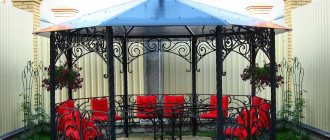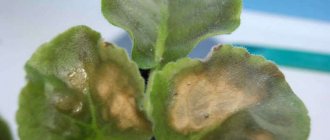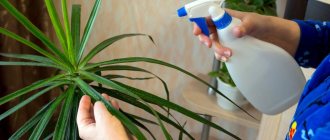The warm, humid forests of South and Central America are home to the beautiful Calathea. The ancient Greeks wove baskets from calathea leaves. But modern lovers of domesticated flora have appreciated the beauty of rich green painted plants from the arrowroot genus. This plant may lose its beauty or die completely if measures are not taken in a timely manner to treat diseases and destroy pests.
There are about 130 species of this large-leaved plant. And among them there are perhaps only a dozen who will feel truly comfortable at home.
How to care for calathea at home?
The tropical plant loves good lighting, warm rooms and high humidity.
Therefore, when caring for calathea at home, you must follow the following rules: 1. Lighting
should be good, but without direct sunlight. Otherwise, dry spots will appear on the beautiful leaves, and the leaf blades themselves will turn brown. Foliage can also lose its decorative properties due to lack of light. In this case, the leaves turn pale and lose their individual pattern. Therefore, it is best to place the flower pot in light partial shade.
2. Air temperature
should not be lower than +16 degrees. However, plants do not like extreme heat. But most importantly, the bushes should not be in a draft.
3. Watering
should be plentiful in spring and summer. Water cannot be left in the pan; it must be poured out immediately. In winter, if the room is not hot, watering is slightly reduced. The soil in the pot should be slightly moist, but not wet. But the most important thing is that you should water with warm water, at a temperature 2-3 degrees above room temperature. At the same time, it should be soft, melted or rainy. If there is nowhere to get such water, then add peat to a container with plain tap water (two handfuls per bucket of water). After a day, the water can be used for irrigation.
4. Air humidity
Decorative foliage plants love increased temperatures. At home it should be about 90%. There is no such humidity in apartments and houses, so the foliage must be sprayed frequently, especially in winter, when the heating radiators are turned on. You should also wipe the leaves with a wet sponge. However, specimens with velvety leaves cannot be moistened in this way. Therefore, they are placed on a tray with wet moss, expanded clay or pebbles. In this case, the bottom of the pot should not touch the water.
5. Calathea fertilizer
should be carried out regularly, but so as not to overdo it. From April to August, the plant only needs to be fed once every two weeks. Fertilizers for decorative foliage plants are used for this purpose. Calathea Crocata (saffron) and Varshevich require fertilizers for flowering plants. In this case, the fertilizer should be diluted twice as much as indicated by the manufacturer (the concentration should be half as much).
Calathea saffron
Plants from the Marantaceae family grow well and do not lose their decorative appearance in florariums, aquariums or other glass containers. It is easy to maintain high air humidity in them.
Reviews from flower growers
It is very capricious to humidity, it is very difficult to create a certain atmosphere for it, I have a fountain in a small house, so I placed it as close as possible to the fountain and also spray it almost 3-4 times a day, otherwise it begins to fold its leaves.
ENat https://forum.bestflowers.ru/t/kalateja-calathea.1023/
My calathea lived for six months without problems, producing leaf after leaf. The ends dried out a little, but I sprayed it three times a day. Then I started feeling bad. I once went into a store, complained about my calathea, and they offered, as an exception, to help me bring it back to life. They transplanted it for me, planted it in some cool soil, and treated it for pests. And now my calathea comes back to life! Already the fourth new leaf is growing.
Lyudmilochka https://cvetoforum.ru/topic965–15.html
A few words about watering - it should be regular. Do not flood, of course, we are waiting for the top layer of soil to dry out. Water for irrigation must be settled or filtered. And for any plant. Any sunny side will do, just keep in mind that calathea is sun-loving, but direct sunlight will cause burns on the leaves.
Vasilisa https://greenforum.com.ua/showthread.php?t=3651
Despite the fact that calathea is quite capricious and whimsical, it is very popular among gardeners. After all, its unusually beautiful leaves are a real decoration for any interior. If you are ready to create a humid microclimate for this sissy and devote a little time to her every day, she will fully thank you with her bright tropical beauty.
- Author: Oksana Kirichek
Hello! I'm Oksana. I am a financier by education and profession, and a copywriter by vocation. Creating articles is a very exciting and useful hobby for me. Rate this article:
- 5
- 4
- 3
- 2
- 1
(1 vote, average: 5 out of 5)
Share with your friends!
How to transplant calathea?
Adult plants are replanted once every two to three years, and young plants - every year. Kalatyas should be transplanted in the spring. It is better to buy soil for them in a specialized store, as it must be loose, breathable and have a slightly acidic reaction. Consult a flower shop seller and ask which of their assortment of soils is suitable for arrowroot.
You can mix your own soil mixture from the following components:
· leaf soil – 1 part;
· peat – 1 part;
· humus – 1 part;
· calcined river sand – ½ part.
The new pot should be 2-3 centimeters larger than the old one. Its bottom is first covered with drainage, then with a small layer of nutritious soil. Before transplanting, the calathea needs to be watered. When the water saturates the soil, the bush is carefully removed from the pot along with the earthen lump and placed in a new container. On the sides and top, the roots are covered with prepared soil mixture and watered. When the soil settles, you will need to add a little more.
Calathea propagation
Where can I buy a plant?
You can buy calathea in offline and online flower shops. The cost ranges from 200 to 3 thousand rubles, depending on the type and size of the plant.
What to do immediately after buying a flower?
You need to accustom the plant to new conditions gradually; to do this, you need to place it for 2 weeks in a bright but shaded place where it is warm, there are no drafts or dampness.
After adaptation, the calathea must be replanted, completely replacing the soil and flowerpot, treated with Zircon using a spray bottle and watered generously.
Pests and diseases of calathea
Dry air at home is the first reason for the appearance of pests on the plant in the form of spider mites, scale insects and thrips. If the leaves on the calathea dry, curl or turn yellow, you should carefully examine them from the underside:
· spider mites can be recognized by small dots on leaves, sticky coating and thin cobwebs;
· thrips look like small light dots on top of the foliage and on the stems; they form numerous colonies on the bottom of the leaves;
· Scale insects are small brown plaques that sit firmly both on the leaves and on their cuttings.
To get rid of pests, it is necessary to spray the bushes with special insecticidal preparations. You can first try to destroy thrips and scale insects with a soap solution.
The trunk has wrinkled
The trunk of the calathea is formed from dead old leaves. In a healthy plant, it is elastic and matches the color of the leaves. There should be no stains or sticky residues.
Calathea whose trunk has shriveled needs urgent treatment. This symptom indicates that the plant is dying. If the problem is not noticed in time, the barrel may twist at an unusual angle.
This happens because the roots rot and the flower stops receiving nutrients. It is difficult to save the calathea in this case. It is recommended to cut off the crown and root it.
Calathea turns yellow
The lower leaves on the bush turn yellow and die over time. Instead, new, young leaves then appear. This is a natural process for the plant. But if the leaves turn yellow on the entire flower, then the reasons may be:
· the plant is cold;
· overdose of fertilizers;
· too frequent or, conversely, insufficient watering.
Do not forget that the flower requires warmth, fertilizing only in spring and summer with low concentration fertilizers and always slightly moistened soil.
If watering is frequent or water stagnates in the tray, the roots of the plant will begin to rot, which is why the leaves turn yellow. Such a bush will need to be transplanted into new soil, after cutting off the rotten roots. Before planting, the cuttings must be sprinkled with crushed coal.
The roots are rotting
The leaves of the calathea plant turn yellow, the stem and roots rot, most often due to hypothermia and excessive watering. Novice gardeners often do not know how to properly care for the fastidious calathea, so a number of problems arise.
To eliminate unpleasant symptoms, it is necessary to reduce the amount of watering and raise the air temperature to +23-28 °C.
Note! If the plant is on a cold windowsill, it must be removed from there immediately.
Reproduction methods
Dividing the bush
When transplanting calathea, which is carried out in the spring, the rhizome of an adult bush can be divided into parts if desired. It should be taken into account that each of the divisions must have several formed roots and leaf plates. Plant the cuttings in individual pots, reaching 70–90 mm in diameter, which are filled with arrowroot substrate. Place them in a shaded area and provide them with warmth and high humidity. To do this, it is recommended to place the pots on a tray filled with wet expanded clay, and a working heating device should be located not far away. Rooting cuttings takes a very long time, and the final result depends on how well you take care of them.
Propagation by cuttings
Very carefully cut off the above-ground cuttings from the mother bush. For rooting, it is planted in a moistened substrate, after which it is covered with a cut-off plastic bottle or a transparent bag. It will be possible to remove the cover only when the cuttings take root. When starting cuttings, you need to take into account that the cutting may not give roots, and this happens quite often.
Growing from seeds
It is extremely difficult to grow calathea from seeds, since even high-quality seed material may not sprout. Take a bowl and fill it with a substrate consisting of sand and leaf soil (1:2), after which the seeds are sown in it. Crops are harvested in a warm place (from 21 to 25 degrees). After the first pair of true leaf blades have formed on the emerging seedlings, they will need to be planted into a box filled with the same substrate that is used for sowing. Grown and strengthened plants are transplanted into separate pots.
Calathea - home conditions. [Hope and Peace]
Features of cultivation
The main feature of calatheas is their unusual leaves, but there are other properties and distinctive features that you need to know about if you are going to care for your homemade calathea. In most plant species, underground shoots form a superficial root system, from which rosettes of large oval leaves up to 30-40 cm long grow on long petioles. The height of a calathea flower can reach 70-90 cm. The flowering of calathea is unattractive, with the only exceptions being calathea saffron and calathea Varshevich, whose inconspicuous flowers are hidden behind bright bract leaves of cream, white, orange and pink shades.
The home flower Calathea is very demanding to care for, but there are species that are more adapted to indoor growing conditions and those that are less adapted. The first include Calathea Bachema, as well as decorated, Makoya, striped, Veicha (Vicha) and some others.
Kalati have one feature common to all arrowroots: in the evenings, the leaves of the plant fold and rise upward, like palms during prayer, and in the morning the leaves lower and open. For this reason, calathea, like arrowroot, is called the “prayer flower.”











